
| KIT #: | IT5608 |
| PRICE: | £87.50 |
| DECALS: | One option |
| REVIEWER: | Richard Reynolds |
| NOTES: | Includes photo etch fret |

| HISTORY |
The general history for this class of vessel is covered in the excellent
photographic reference manual supplied in the kit. Therefore, I shall focus on
the account of this boat in the Italian Ladoga Detachment and in Finnish Navy
service.
The Continuation War (jatkosota in Finnish) the second of two wars fought
between Finland and the Soviet Union during WWII began on 25th June
1941 when 487 bombers of the Soviet Air Force bombed Finnish territory.
Acts of war between the two countries began on 22nd of June 1941 when
the Germans launched Operation Barbarossa, their invasion of the Soviet Union.
The Finns sought to re-gain land conceded to the Soviet Union in the preceding
Winter War. Once these objectives were achieved at the pre-WWII border, the
offensive was stopped some 30km from Leningrad.
One of the primary objectives of the Finnish forces was the Ladoga Karelia
region. Once Finnish troops had reached the shores of Lake Ladoga early in the
war, they began re-establishing a flotilla on the lake and formed a headquarters
in Läskelä on 02nd August 1941.
By 06th August 150
motorboats, 2 tugs (which were used as minelayers) and 4 steam ferries had been
transferred there. In addition the Finns had installed a number of coastal
batteries and installations around the shores of the lake.
As the Finnish land forces progressed along the shores of the lake the
headquarters were moved, firstly to Sortavala and then to Lahdenpohja.
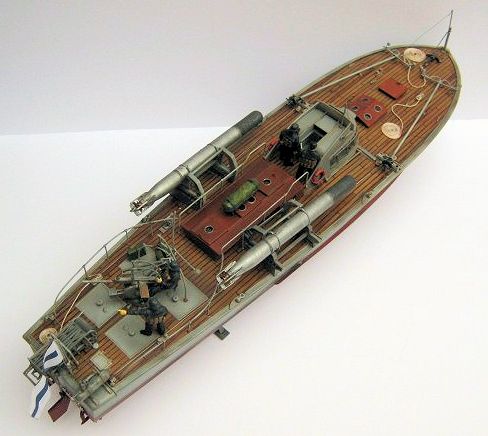 Finnish Lieutenant General Paavo Talvela and Colonel Järvinen formulated a plan
to disrupt Soviet shipping supplying the besieged city of Leningrad. They
presented this idea to the German regional headquarters and were surprised when
their plan was enthusiastically received. In response, both the Germans and
Italians sent Naval Units in support of the proposed operation with the combined
Finnish/German/Italian unit being formed on the 17th May 1942. The
unit was named Laivasto-osasto K (LOs.K., Naval Detachment K).
Finnish Lieutenant General Paavo Talvela and Colonel Järvinen formulated a plan
to disrupt Soviet shipping supplying the besieged city of Leningrad. They
presented this idea to the German regional headquarters and were surprised when
their plan was enthusiastically received. In response, both the Germans and
Italians sent Naval Units in support of the proposed operation with the combined
Finnish/German/Italian unit being formed on the 17th May 1942. The
unit was named Laivasto-osasto K (LOs.K., Naval Detachment K).
The unit consisted of four Italian MAS serie 2a torpedo boats (Motoscafo Armato
Silurante: Torpedo Armed Motorboat), four German KM minelayers and the Finnish
torpedo boat Sisu. The German and Italian units were divided into two groups
under Finnish command, the Italian unit XII Squadriglia was the first to arrive
on June 22nd, the boats having made a 3100km journey across land from
La Spezia to Stettin, where the boats were shipped to Helsinki in the steam ship
SS Thielbeck on the 09th June, then towed along a coastal sea lane
and Saimaa channel, and finally transported by rail from Punkasalmi by Lake
Puruvesi to Lahdenpohja by Lake Ladoga.
The 1917 vintage Italian-built Sisu was the only Finnish torpedo boat on the
lake up until the arrival of the XII Squadriglia boats. The German KM Boats
arrived in Helsinki on June 27th, and were transported overland,
arriving in Lahdenpohja on 07th July. The combined unit commenced
operations on the Leningrad supply convoys on 14th August.
The unit’s primary task was to harass Soviet shipping supplying the city of
Leningrad. The unit also staged attacks on enemy bases and coastal installations
and conducted limited landing operations on the shores of Lake Ladoga. Some
smaller Soviet patrol boats and several barges were attacked and sunk during
1942 and 43. The Finnish Ladoga Flotilla engaged the Soviet Ladoga Flotilla on
several occasions during this period.
The unit despite these engagements had failed in its primary objective of
disrupting Soviet shipping and as such was disbanded. The Italian MAS Boats were
re-assigned to Tallinn in Estonia, at the end of October 1942. From here they
were purchased by the Finnish Government on 05th May 1943 and
formally handed over to Kapteeniluutnantti Herlevi the liaison Officer for
German and Italian Navies in Lake Laatokka and the Gulf of Finland in 1942 and
1944.
 The XII Squadriglia MAS (Mezzi d’Assalto)
(Italian for “12th Assault Vehicle Squadron”) was a formation of
the Italian Royal Navy (Regia Marina).
The XII Squadriglia MAS (Mezzi d’Assalto)
(Italian for “12th Assault Vehicle Squadron”) was a formation of
the Italian Royal Navy (Regia Marina).
The request for assistance on Lake Ladoga to the Regia Marina resulted in the
formation of XII MAS in April 1942 at La Spezia on the Tyrrhenian Sea. XII
Comprised of four MAS serie 2a boats, these were: MAS 526, 527, 528 and 529
which displaced 22 tons with a length of 18.7m and a top speed of 42 knots. The
boats were armed with 2, 450mm torpedoes, one 20mm Breda cannon, depth charges
and a mount for a 12.7mm MG (Which was invariably discarded). The range of these
vessels was 330nm at 42 knots and 836nm at 8 knots.
The package included crews and support staff, equipment and maintenance support,
a total of 99 men under the command of Capitano di Corvetta Bianchini.
XII MAS Served on Lake Ladoga for 90 days, making 59 sorties and engaging in 17
actions, during which they sank a Soviet Gunboat (Bira class), a merchant ship
of 1300 tons, and several barges. Despite this, their efforts proved too little
to affect operations on the lake and they were withdrawn.
On the 05th May 1943 the Italian MAS boats were formerly handed over
to the Finnish Navy in Tallinn Estonia. Upon their return to Finland they were
overhauled and received new designations. These were:
·
Jylhä (J1, Ex MAS 526)
·
Jyry (J2, Ex MAS 527)
·
Jyske (J3, Ex MAS 528)
·
Jymy (J4, Ex MAS 529)
The class was designated “moottoritorpedovene jymy” or Jymy JI Class Motor
Torpedo Boat. Between mid-1943 and the armistice with the Soviet Union in 1944,
the Jymy class of boats served in the Gulf of Finland.
The primary objective of the Finnish Navy during the period 1943 to the
armistice in 1944 was anti-submarine mine warfare. Mine barrages were
constructed at Kalbadagrund (named “Pälkjävi”) which had 100 mines in two lines.
At "Seehund" west from Lavansaari, 200 mines and 250 anti-sweeping devices, were
laid during August. To prevent Soviets clearing routes through "Seeigel".
Additionally mine barrages were laid in "Norppa" and "Ontajärvi" south from
Someri in July-August with Smaller offensive barrages, "Sauna", "Peninkulma",
"Tiger" and "Brummbär" These were laid in sea ways between Kronstadt and
Lavansaari. The German air force dropped 200 mines in the Kronstadt area.
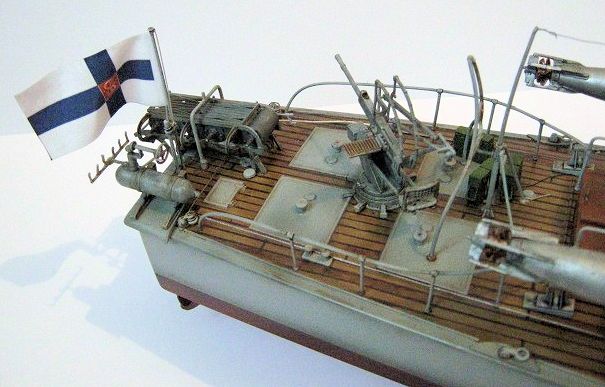 The Soviet submarine fleet had broken through the mine barrage too easily in
1942. Action was required to protect Finnish interests in the Gulf. Larger
barrages and a double submarine net were added, additionally the use of mine
laying patrol boats was increased, types which included German M-class sweepers,
the four Jymy class torpedo boats, and at the end of the summer of 1943, “Hurja”
class boats of the second MTB flotilla dropped mines in the area of the Diamant
shallows, northeast from Seiskari.
The Soviet submarine fleet had broken through the mine barrage too easily in
1942. Action was required to protect Finnish interests in the Gulf. Larger
barrages and a double submarine net were added, additionally the use of mine
laying patrol boats was increased, types which included German M-class sweepers,
the four Jymy class torpedo boats, and at the end of the summer of 1943, “Hurja”
class boats of the second MTB flotilla dropped mines in the area of the Diamant
shallows, northeast from Seiskari.
A change in Finnish leadership in August 1944 precipitated a peace agreement
between Finland and the Soviet Union. This resulted in the Lapland war between
Finland and Germany and led to the evacuation of all German forces from Finland
to Norway and brought about an end to Finland’s involvement in the Second World
War.
The Jymy class boats were eventually converted into patrol boats in 1949 and in
accordance with the restrictions placed upon the Finnish Navy by the Paris Peace
Treaty, the J-class vessels were scrapped in 1961.
| THE KIT |
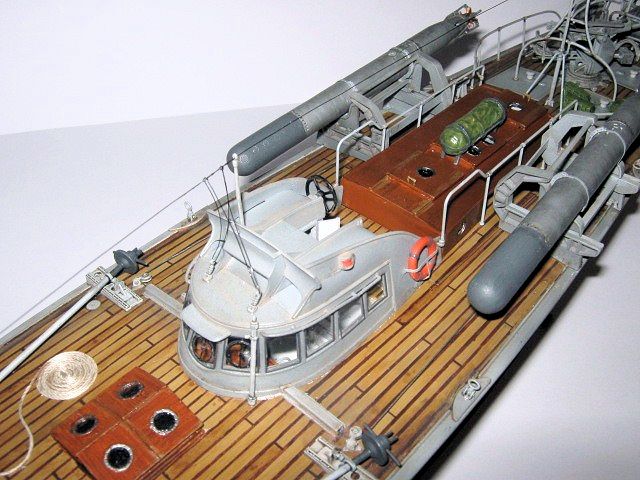
| CONSTRUCTION |
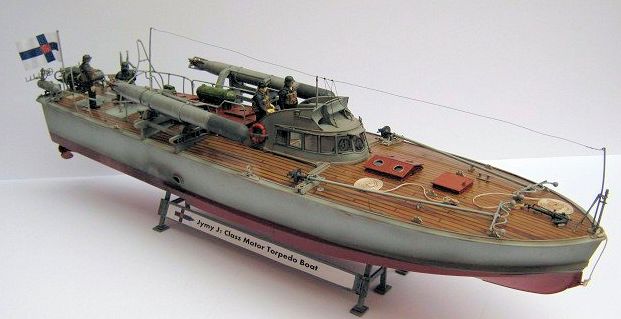
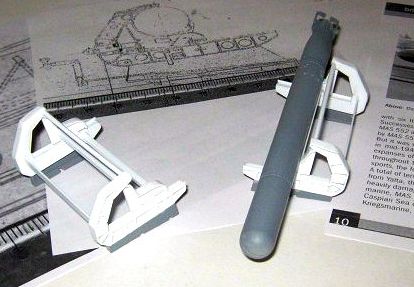
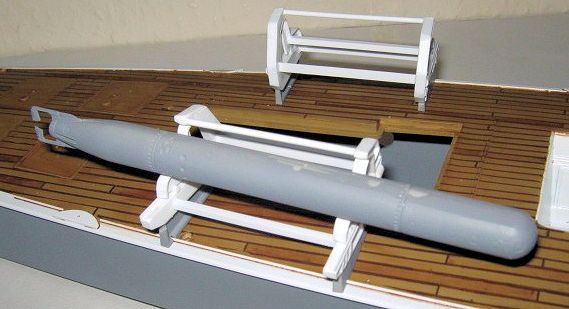 2.5mm and plastruct round rod 2mm.
2.5mm and plastruct round rod 2mm.
| COLORS & MARKINGS |
The
engine covers to the rear of the deck and additional deck-fittings were all
painted using White Ensign Models ‘Grigio Chiaro’ before receiving a light wash
of ivory black and burnt umber oil paint.
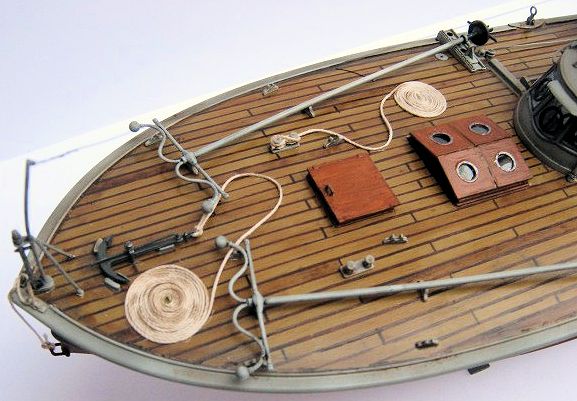 The deck fittings were then post-shaded in humbrol 67 before being airbrushed
with Alclad gloss. The hull was sanded down using a fine grit wet and dry paper
available from an auto-supplies outlet. It was then primed using grey
auto-primer and the process repeated until I was satisfied with the result.
The deck fittings were then post-shaded in humbrol 67 before being airbrushed
with Alclad gloss. The hull was sanded down using a fine grit wet and dry paper
available from an auto-supplies outlet. It was then primed using grey
auto-primer and the process repeated until I was satisfied with the result.
The hull was prepped and primed with grey auto-primer before being given at
least 5 coats of White Ensign Models Grigio Chiaro (Light Grey) (RM 02) from
their Regia Marina range.
Once dry, the lower-hull was masked with Tamiya tape and the area below the
boot-line was painted with US Navy Anti-Fouling Red (M 06) also from the White
Ensign “Colourcoats” range.
The deck was then screwed to the hull for the final mock-up prior to the deck
fittings being added and was photographed. All of the deck fittings were now
pre-prepared by priming and spraying with White Ensign Model’s Grigio Chiaro.
These included the railings, bollards, cleats, fairleads, the rudder assembly,
the microphone booms for the anti-submarine detection equipment, the smoke
generator and depth charge rack and the parts for the Breda 20mm 35 machine gun.
Once dry, the gun, depth charge rack and smoke generator were assembled and put
to one side.
| FINAL CONSTRUCTION |
The ammunition boxes were constructed including the etched-brass handles. Three
boxes were placed behind the gun. On the 3a and 4a serie boats, the boxes are
stowed in baskets on the railings around the Breda 35 gun. As I saw no evidence
of these baskets in photographs of the Jymy boat, I elected to discard the
baskets in favour of just three boxes placed behind the gunner.
Next, the torpedoes were put together and painted using a combination of Humbrol
Metal Cote 27002 and Humbrol 67 dark grey. Finally, the rear cabin and forward
hatch covers were painted using a combination of Windsor & Newton yellow Ochre
and Burnt Umber oils in a 60/40 combination followed by a sparing amount of
thinned burnt umber paint streaked over the surfaces whilst still wet using a
fan brush to achieve a wood-stained effect.
Sections 28 to 35 of the instruction booklet were then completed which was the
fixture of all of the deck fittings. The railings and masts were the last items
to go on, the jack-staff and flag being the last items applied.
 The figures were a combination of Italeri’s 1/35 M.A.S. crew with ICM’s 1/35
1917-1918 WWI Assault Troops Helmets. The Finnish Armed Forces bought surplus
equipment from the Austro-Hungarian Army at the conclusion of the First World
War, including the distinctive “Stahlhelm”, which I have used on three of the
figures. Apart from the addition of the helmet, the figures are straight from
the box as it has been indicated that The Italian M.A.S. crews donated much of
their equipment to the Finns including their life-vests.
The figures were a combination of Italeri’s 1/35 M.A.S. crew with ICM’s 1/35
1917-1918 WWI Assault Troops Helmets. The Finnish Armed Forces bought surplus
equipment from the Austro-Hungarian Army at the conclusion of the First World
War, including the distinctive “Stahlhelm”, which I have used on three of the
figures. Apart from the addition of the helmet, the figures are straight from
the box as it has been indicated that The Italian M.A.S. crews donated much of
their equipment to the Finns including their life-vests.
The figures were primed with Tamiya white primer and base-coated with a wash of
Windsor & Newton yellow ochre oil. Once dry flesh-tones of yellow ochre, burnt
sienna and flake white oils were added in a ratio of 2,1,4. The uniform was
base-coated with Tamiya XF-17 Sea blue and given a wash of Vallejo German grey.
The life vests were based with Citadel “Rhinox-Hide” and dry-brushed with
Citadel “Tallarn Sand”.
The Finnish Naval Ensign was a BECC flag supplied by ModelFlags.com which was
prepared by painting the outside edges
of the material with fabric glue, being allowed to set and then cut out using a
metal ruler and a
fresh
scalpel blade. A section of material was left to glue and wrap around some
0.75mm Caldercraft natural rigging thread.
Caldercraft 1.00mm natural rigging thread was used for the anchor rope and the
fore and aft mooring ropes, which were affixed to the deck with a small blob of
thick cyanoacrylate and coiled as per pictures of the Jymy class docked in
Tallinn in 1943.
Finally, the aerial wires were added, these were 0.2mm black copper wire supplied by little-cars.com and formed the final stage of construction before a coat of Alclad 2 gloss was applied.
| CONCLUSIONS |
This model presents excellent value for money. Building the “straight from the
box” serie 3a or 4a presents the modeller with many options for Mediterranean or
Black Sea vessels. For the more adventurous, the 2a conversion increases options
for Italian operated examples and can expand this versatile kit into the navies
of Finland and Sweden. Highly recommended.
| REFERENCES |
·
The Finnish Navy from 1918 to 1969. Helsinki:
Marine Officers' Association, 1968.
·
Orvo - Pirhonen, Jouko - Kill beads, Kullervo: Ships
of wood, iron men - Motor Torpedo Boat fighting the Gulf of Finland 1941-1944. Porvoo:
Werner Söderström Corporation, 1956.
·
The Italian Navy in Finland:
http://www.ww2f.com/eastern-europe-october-1939-february-1943/25227-italian-navy-finland.html
·
War on Lake Ladoga:
http://heninen.net/laatokka-war/english.htm
·
Further photographs of the build can be seen at:
http://www.themodelgallery.wordpress.com
February 2013
If you would like your product reviewed fairly and fairly quickly, please contact the editor or see other details in the Note to Contributors.